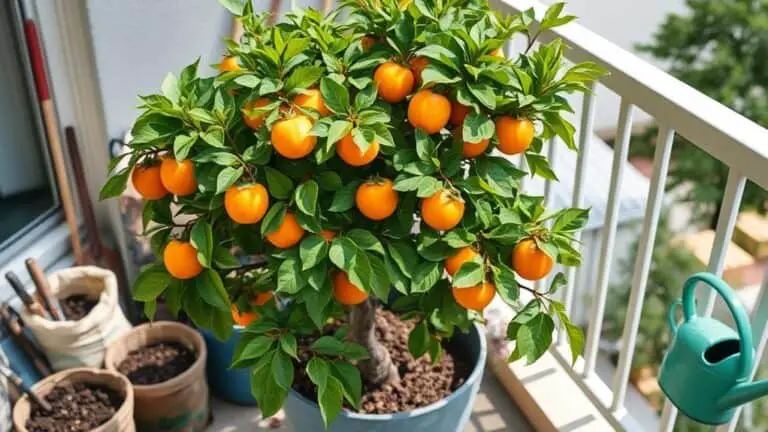How To Tell Christmas Cactus And Easter Cactus Apart
When it comes to distinguishing between a Christmas cactus and an Easter cactus, I always start by examining the leaf shapes and flower characteristics. The Christmas cactus has segments that are scalloped with pointed edges, and its flowers are tubular and droop down. In contrast, the Easter cactus boasts rounded, smooth-edged leaves and star-shaped flowers that face upwards. However, there's more than just leaves and blooms to take into account. Their growth habits and seasonal blooming times offer additional clues that can make identification much easier. Curious about these other distinguishing features? Let's explore further.
Leaf Shape
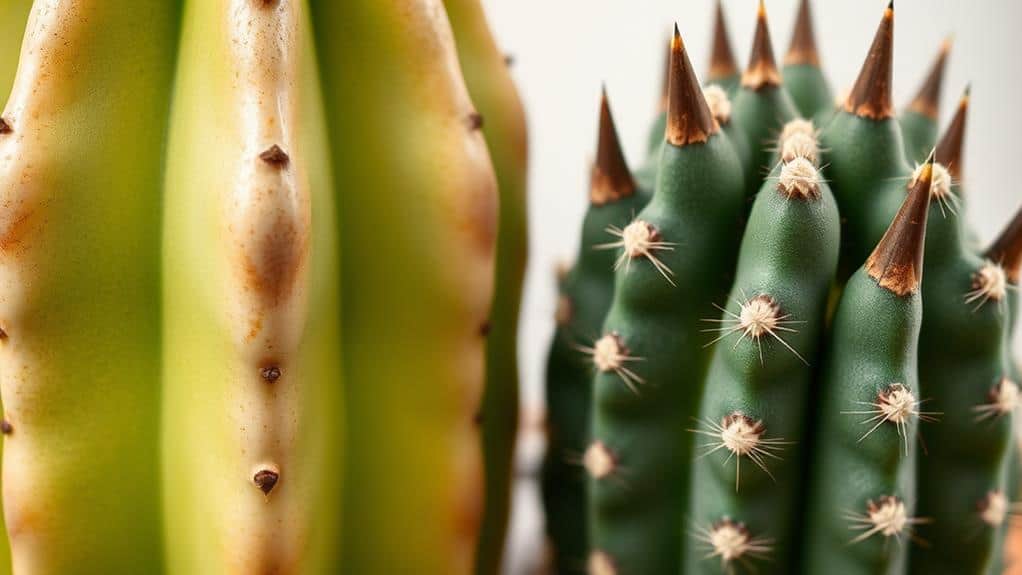
When trying to tell Christmas cacti and Easter cacti apart, the first thing you should look at is their leaf shape.
The Christmas cactus has scalloped, tear-shaped segments with pointed leaf edges that might remind you of claws. In contrast, the Easter cactus features rounded, smooth leaf edges without any notches, making the leaves look more cylindrical.
You'll also notice that the Christmas cactus's leaves are flatter and more segmented, while the Easter cactus tends to grow upright. Observing these differences in leaf structure is key.
Bristles and Texture
When trying to tell Christmas and Easter cacti apart, the texture of their segments can help a lot.
Christmas cacti have smooth segments without any bristles, making them easy to identify by touch.
In contrast, Easter cacti have soft bristles between their leaf segments, which you can feel with your fingers and use as a quick identification method.
Smooth Vs. Bristled Segments
Though both the Christmas cactus and the Easter cactus may seem similar at first glance, their leaf segments hold a key distinction. Christmas cacti have a smooth texture on their leaf segments, contributing to their sleek appearance. Easter cacti, however, feature bristles between their segments. These bristles aren't stiff or pointy, making them easy to feel and identify. When trying to tell these two plants apart, gently touch the leaf segments. If you feel bristles, you've likely got an Easter cactus. If it's smooth, it's probably a Christmas cactus. Here's a simple table to help:
| Feature | Christmas Cactus | Easter Cactus |
|---|---|---|
| Leaf Texture | Smooth | Bristled |
| Segment Ends | Smooth | Bristled |
| Touch Feel | Sleek | Slightly Rough |
| Ease to Identify | Moderate | Easy |
| Common Time | December | April |
With this knowledge, you'll confidently identify your cacti!
Safe to Touch
Both Christmas cacti and Easter cacti are safe to touch, but their textures differ greatly.
Christmas cacti have a smooth texture with no bristles, making them pleasant and easy to handle. Easter cacti, however, feature soft bristles between their leaf segments. These bristles aren't stiff or pointy, so they won't harm you.
To help you remember the differences, consider:
- Christmas cacti: Smooth texture, no bristles
- Easter cacti: Soft bristles between segments
- Both: Safe to touch
When you feel these plants, the presence of bristles on the Easter cactus is a helpful clue. Observing texture and bristles can make identifying these cacti a breeze.
Quick Identification Method
Feeling your way to identifying a cactus can be surprisingly effective. If you want to quickly tell a Christmas cactus from an Easter cactus, just touch it. Christmas cacti have a smooth texture without any bristles. They feel sleek and soft. Easter cacti, however, have bristles between their leaf segments and at the ends. Don't worry, these bristles are not stiff or pointy—they're soft and safe to touch.
Here's a simple table to help you remember:
| Cactus Type | Texture | Bristles Location |
|---|---|---|
| Christmas Cactus | Smooth | None |
| Easter Cactus | Soft bristles | Between and at leaf ends |
Flower Characteristics
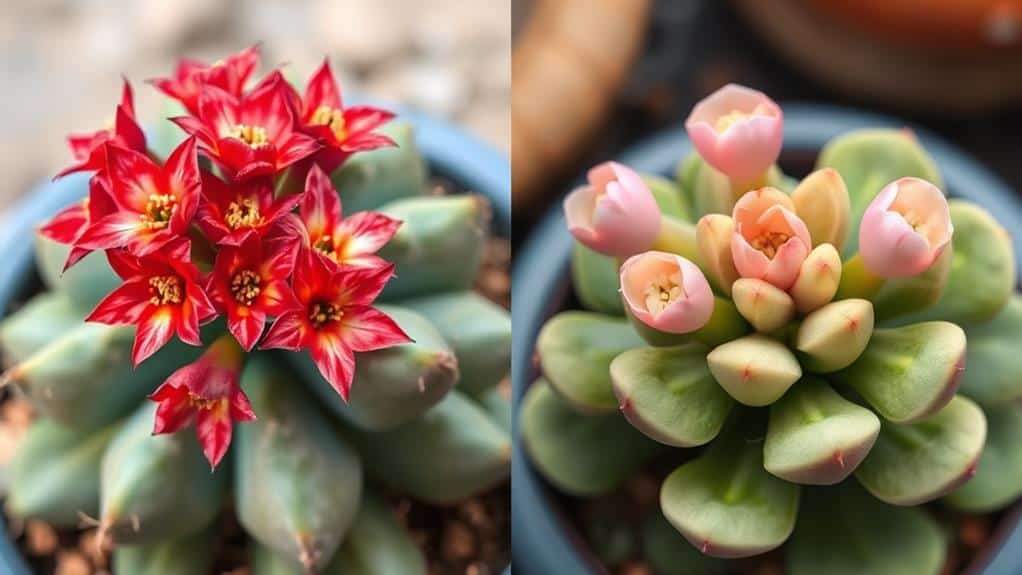
When trying to tell a Christmas cactus from an Easter cactus, the flower characteristics offer some clear distinctions.
Christmas cactus flowers are tubular and typically droop, featuring purple-brown anthers. In contrast, Easter cactus flowers are open and star-shaped with yellow anthers.
Consider these points:
- Shape: Christmas cactus flowers are tubular, while Easter cactus flowers are star-shaped.
- Anthers: Christmas cactus has purple-brown anthers; Easter cactus has yellow.
- Orientation: Christmas cactus flowers droop downward, but Easter cactus flowers face upwards.
Additionally, the color range can help you identify them.
Christmas cactus flowers come in shades of pink, red, white, and purple. Easter cactus flowers appear in pink, orange, red, or white.
These details make identification easier and more accurate.
Blooming Seasons
Now that we've explored the flower characteristics, let's talk about another significant factor in distinguishing these cacti: their blooming seasons.
The Christmas cactus typically blooms from late fall to winter, specifically from January to February. In contrast, the Easter cactus has its blooming period in early spring, from March to May.
Understanding these blooming periods is essential for proper care. For instance, the Christmas cactus needs around six weeks of short-day conditions to start blooming, while the Easter cactus requires a longer period of eight to twelve weeks.
Additionally, don't confuse the Christmas cactus with the Thanksgiving cactus, which blooms earlier, from November to December.
Knowing these details will help you care for and enjoy your cacti better.
Size and Growth Habit
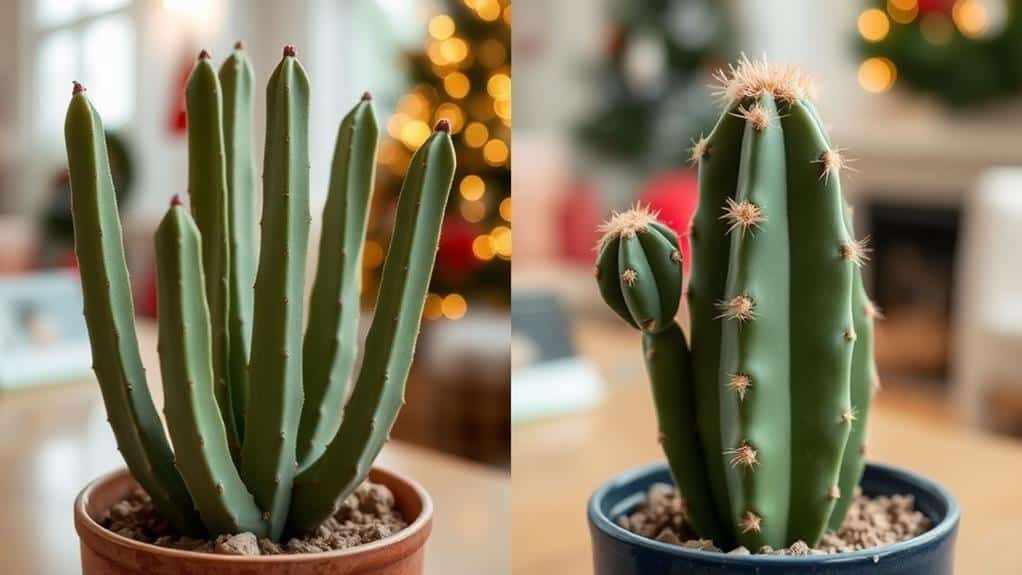
Size and growth habit are essential factors to evaluate when distinguishing between Christmas and Easter cacti.
Christmas cacti, known scientifically as Schlumbergera, tend to be larger and more expansive. They exhibit a trailing growth habit, often drooping considerably as they mature.
On the other hand, Easter cacti, or Rhipsalidopsis, are generally more petite and maintain an upright, bouncy form.
This difference in growth habit means:
- Christmas cacti have a sprawling, cascading shape.
- Easter cacti appear more compact and bushier.
- Christmas cacti occupy more vertical space in similar pot sizes.
When comparing the two, keep in mind these size and growth habit differences to help you identify which cactus you have.
Understanding these traits will guarantee your plants thrive.
Origin and Habitat
While understanding the size and growth habit of Christmas and Easter cacti is helpful, knowing their origins and habitats provides even more insight into their care needs.
The Christmas cactus (Schlumbergera bridgesii) originates from the tropical rainforests of Brazil. It thrives in the shady, cooler understory of trees in humid conditions.
On the other hand, the Easter cactus (Rhipsalidopsis gaertneri) comes from Brazil's drier forests. It adapts to slightly warmer and less humid environments. The Easter cactus can tolerate brighter conditions compared to the Christmas cactus.
Watering Needs
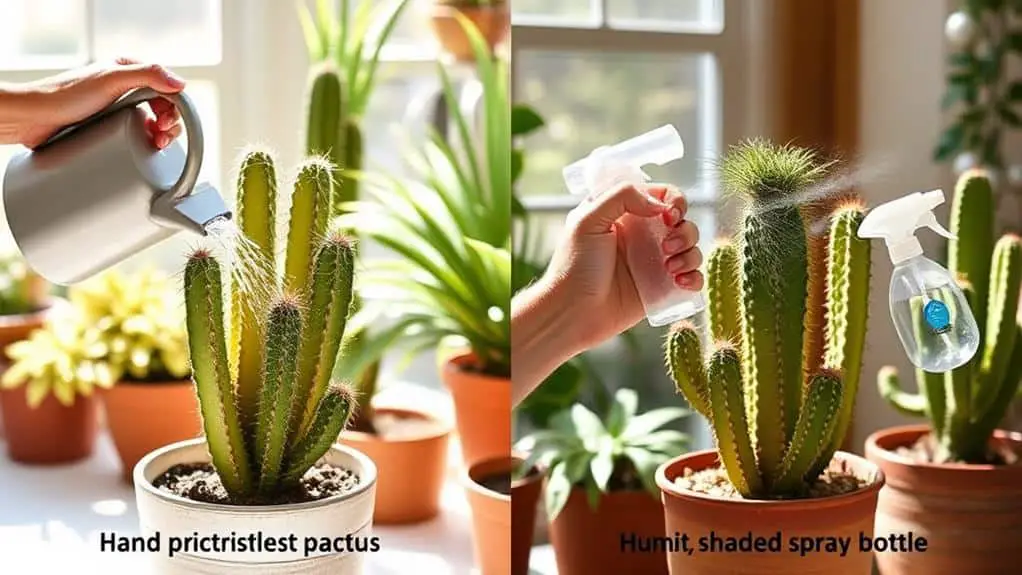
When it comes to watering, Christmas cacti and Easter cacti have different needs, so let's make sure we get it right.
Christmas cacti require more frequent watering during their blooming period, keeping the soil slightly moist but never soggy.
On the other hand, Easter cacti prefer drier conditions during their blooming phase, so we need to be careful not to overwater them.
Frequency of Watering
Determining the watering needs of Christmas and Easter cacti can be a bit tricky, but it's crucial for their health and blooming success.
Christmas cacti need more frequent watering during their blooming period. Keep the soil moist while the buds are forming.
Easter cacti, however, require less water, especially in spring when they bloom.
To help you remember:
- Christmas cacti need more water during blooming.
- Easter cacti need less water, especially in spring.
- Check soil moisture 1 inch deep before watering.
Both types should have their soil dry out between waterings.
Christmas cacti can handle a bit more moisture without risk, but Easter cacti are sensitive to overwatering.
This careful balance guarantees your cacti thrive and bloom beautifully.
Soil Moisture Levels
Now that we recognize how to manage the watering frequency for Christmas and Easter cacti, let's focus on grasping their soil moisture levels.
Christmas cacti, and their cousins the Thanksgiving cacti, prefer slightly moist soil, especially during their blooming period. I make sure to water them when the top inch of soil feels dry.
On the other hand, Easter cacti need less frequent watering. They thrive when allowed to dry out more between waterings. Overwatering can lead to root rot, so checking soil moisture levels is essential.
Well-draining soil is important for both types. During non-blooming times, I water sparingly, keeping the Easter cactus drier compared to the Christmas cactus. This balance helps them stay healthy and vibrant.
Seasonal Watering Adjustments
Understanding the seasonal watering adjustments for Christmas and Easter cacti is essential for their health. Both plants have different needs depending on the time of year.
When it comes to watering, follow these guidelines:
- Christmas cactus: Water when the top inch of soil is dry, especially during its blooming period in fall and winter.
- Easter cactus: Allow the soil to dry out more between waterings to prevent root rot, particularly in spring when it blooms.
- Growing season: Both cacti need more frequent watering, but Christmas cactus might need extra attention due to its active blooming phase.
After blooming, reduce watering for the Christmas cactus to let it rest.
For the Easter cactus, maintain a consistent but lighter watering schedule.
Adjust your watering based on temperature, ensuring both cacti thrive.
Light Requirements
When caring for Christmas and Easter cacti, light requirements play an essential role in their health and blooming cycles.
Christmas cacti thrive in bright, indirect light but should be shielded from direct sunlight to prevent leaf scorch. Easter cacti prefer bright light conditions too and can tolerate slightly warmer temperatures between 65-75°F.
Both types need longer periods of darkness to encourage blooming. Christmas cacti require about 13 hours of darkness for around six weeks, while Easter cacti need approximately 8-12 weeks of longer darkness to stimulate their spring blooms.
Adequate light exposure is imperative for both to maintain healthy growth and guarantee vibrant blooms during their respective flowering seasons. Following these light requirements guarantees your cacti stay happy and blooming.
Propagation Methods
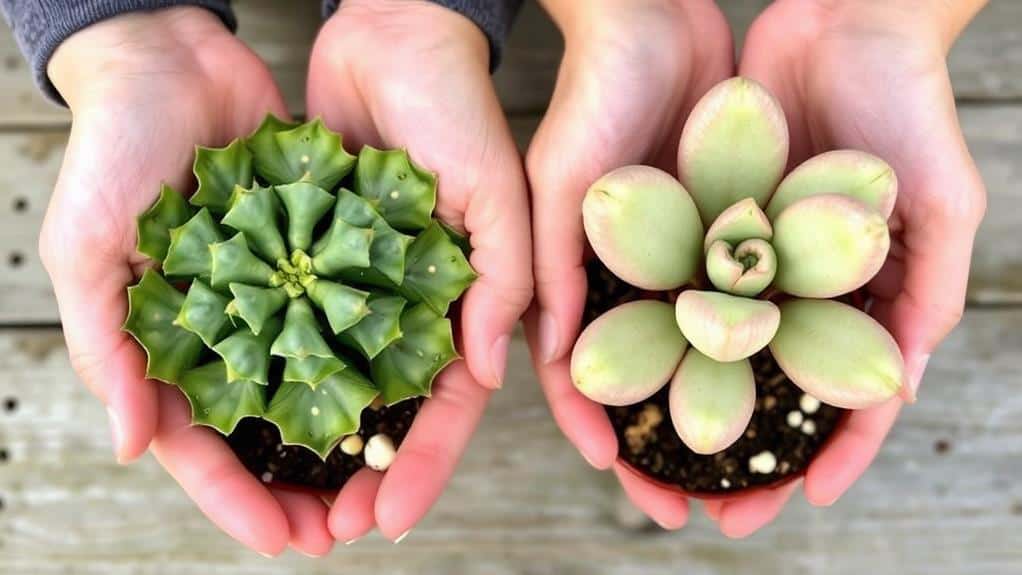
After guaranteeing your Christmas and Easter cacti get the right light conditions, let's talk about propagating these beautiful plants.
For both, the most common propagation methods involve stem cuttings and division.
To propagate by stem cuttings:
- Take a Y-shaped cutting with two or three segments.
- Let the cut end dry for a few days to prevent rot.
- Plant it one inch deep in well-draining potting mix.
For division propagation:
- Carefully separate the root system of a mature cactus.
- Confirm each section has roots and at least one stem segment.
Roots usually develop in three to eight weeks.
You can also root cuttings in water. Keep the cuttings warm and maintain humidity to encourage successful growth.
Happy propagating!
Common Issues
Maintaining the health of your Christmas and Easter cacti can sometimes be a challenge, but knowing the common issues can make all the difference.
Overwatering is a big problem; it can lead to root rot. Always let the soil dry out between waterings.
If you notice leaf drop, it might be due to temperature changes or improper watering.
Pests like mealybugs and spider mites can invade, so keep a close eye, especially when your cactus is growing.
Fungal diseases thrive in moist conditions, so guarantee good air circulation around your plants.
Yellowing leaves usually signal either a nutrient deficiency or overwatering.
Frequently Asked Questions
How Do I Know if I Have a Christmas or Easter Cactus?
To identify your holiday cactus, examine leaf shapes and flower colors. Christmas cacti have scalloped leaves and tubular flowers, while Easter cacti showcase rounded leaves and star-shaped blooms. Their growth habits also differ: drooping versus upright.
How Do You Tell Which Cactus You Have?
To determine which cactus you have, examine the leaf edges and flowering habits. Christmas cactus has scalloped edges and drooping flowers, while Easter cactus has smooth edges and upright flowers. Proper cactus care and potting techniques are essential.
What Does an Easter Cactus Look Like?
An Easter cactus has flat, rectangular leaves with scalloped edges. It blooms with star-shaped flowers in pink, orange, red, or white. For Easter cactus care, remember it's compact and upright. Its origins trace back to Brazil.
What Does an Easter Cactus Look Like?
Easter cactus flowers are star-shaped in pink, orange, red, or white. For Easter cactus care, keep it in bright, indirect light. Its natural habitat is humid forests, so maintain moderate humidity and avoid direct sunlight.
Conclusion
By now, you should feel confident in telling Christmas cactus and Easter cactus apart. Remember to look at the leaf shapes, flower styles, and blooming seasons. Christmas cactus has pointy, scalloped leaves and drooping flowers, while Easter cactus has smooth, rounded leaves and star-shaped flowers. Keep an eye on their growth habits and watering needs, too. With these tips, you'll be well on your way to becoming a cactus expert. Happy gardening!



